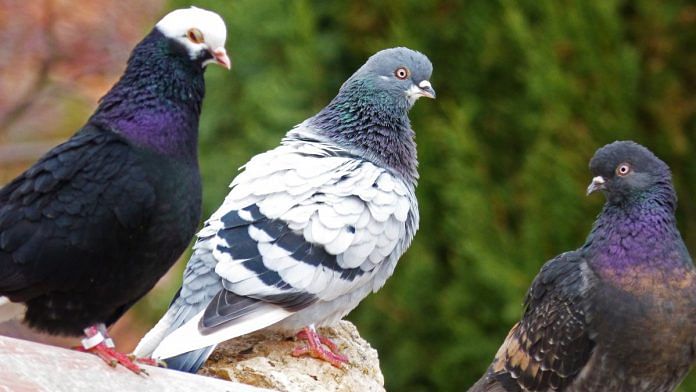India-Pakistan borders are hot, and spying pigeons are the last thing they want. Or deer, or monkeys or locusts. They complicate the LoC politics. Even when Indian and Pakistani leaders visit each other’s country for official summits, it stirs problems. Imagine the trouble with uninvited creatures crossing borders.
But do bin bulaye mehmaan ever come over after taking our permission? I guess not. So what’s the fuss if a colourful bird or two decided to cross the border, albeit without the visa? It’s not like during the coronavirus crisis, you are swamped with guests anyway.
Have a heart, guests are god.
The moment the pink-patched Pakistani pigeon from Shakkar Garh in Sialkot landed along the international border in Jammu’s Kathua district, all radars went off. The villagers caught the pigeon and handed it over to the police, but that wasn’t the end of it. The burning question before the Indian officials now was whether the kabootar, besides being a spy, was also a terrorist. Once all the headquarters were alerted, the pigeon was made to go through a body-search to ascertain if it was wearing a suicide jacket or if there were any explosives hidden in its rear-end.
Unfortunately, nothing was found.
All this time, the Pakistan high commission was waiting to demand consular access to the kabootar and perhaps take the issue to the International Court of Justice, in case India denied. Or at best seek conjugal visitation rights for the ‘K’ prisoner. Alas, it never came to that.
As for India, the kabootar was a threat to the country’s national security, so it was fluttered away. Where did it go? No one knows.
Also read: Pakistanis are not just scared of coronavirus but of ‘colonel ki biwi’ too
The spy who became a traitor
The truth is: the pigeon was turned while it was in India’s custody, and it is now working for the Research and Analysis Wing (RAW), the country’s foreign intelligence agency. And in custody, the pigeon sang. It gave India some names. How else does one explain the expulsion of two Pakistani officials from the embassy in Delhi over charges of espionage? Coincidence much? However, a befitting reply was given by Pakistan — two drones downed in three days. Take that India! Now go figure how to do wedding photography without these captured drones.
The initial interrogation of the pink-patched Pakistani pigeon revealed that it was part of the espionage ring that began its operations in India as early as 1970 with ‘Titar ke do aage titar, titar ke do pichhe titar’. This subliminal messaging based around birds led to the war of 1971 between two friendly neighbours. At the time of repatriation of Pakistani prisoners of war from India in 1974, these powerful racketeers bid farewell to 93,000 swans with ‘O hansini, meri hansini, kahaan ud chali.
For many people, ‘Kabootar ja ja ja’ was an exchange of a love letter, but really it was a shout out to all pigeon spies to return-to-base before India’s cricket team toured Pakistan in 1989. Someone had to keep an eye on the debutant named Sachin Tendulkar.
Then there was a lull during the Kargil War and pigeons were replaced by real warheads, some from the Indian side carried messages for then Prime Minister of Pakistan: “From Raveena Tandon to Nawaz Sharif.”

That was that. After the dust settled, ‘panchhi, nadiya, pawan ke jhonke, koi sarhad na inhein roke’ came as a calling for bird spies to unite. Their unity then led to the India-Pakistan military standoff in 2001.
Also read: The one job that will disappear by 2062 — the job of fighting wars
Spy house is full of animals
It is not only the birds that run spy stations and go back-and-forth without visa constraints in India and Pakistan.
There are monkeys and deer who often cross over and create problems for both the countries. It is a good problem to have, we would say. In 2011, a monkey from India was found in Cholistan. Dodging the locals initially, the monkey was caught and placed at the Bahawalpur zoo; it was renamed Bobby.
Only last year, a pack of langurs were spotted in the bordering village of Kasur. Adding to the excitement of the people, they were seen perched on cellular towers and even the minarets of mosques. What messages must have they sent back home? It is possible they paved the way for India’s actions of 5 August 2019.
Deer from India are frequent visitors to Pakistan — without papers, of course. One was caught in 2016 and handed over to the police by the local people.
And how did Pakistan conclude the deer is an Indian infiltrator? Passport, Aadhar, bank KYC, PayTM number? https://t.co/Y87ARcN5BS
— Shekhar Gupta (@ShekharGupta) November 28, 2016
But it was trained well, so it escaped from the prison where it was kept. Or did it have on-ground support? We think that might have been the case. There are other instances of Indian deer running to Pakistan to avoid persecution. Some 18 of them have landed in the bordering villages in recent times.
Locusts are the new terrorists in town and both India and Pakistan seem to be scared of them. Who knew tiddis could be a weapon of mass destruction. They are playing havoc on the crops and its killing skills are unlike anything we have seen from the pigeons or monkeys or deer. Have both countries found a common enemy in tiddi? There can be ‘good tiddis’ and ‘bad tiddis’ based on the national interests. Are locusts the WMDs that were kept hidden until now? Perhaps Arnab Goswami will know.
The author is a freelance journalist from Pakistan. Her Twitter handle is @nailainayat. Views are personal.




I, an Indian who lingers around in r/Pakistan’s discord came to this article after some Pakistanis shared this in their #serious channel. Know what? They probably didn’t get the joke and took each word quite literally….anyways, brilliant funny piece of writing indeed.
Brilliant piece of writing. There is no one like her. Not in India, not in Pakistan.
When shekhr Gupta said abt Naila that there is no one like her in India or in Pak he was so right. This is a marvelous piece of writing with grit, humor, intelligence. As a reader it gives
me break from the mundane generic way of storytelling. Wait for the next piece eagerly.
A very balanced n neutral write-up with not a single bias or vituperative connotation normally associated with &/or coming from the best of bloggers re anything connected with Indo-Pak relations n goings-on.
Above all: the fun n games the author has indulged in at the expense of the two neighbours is simply outstanding n a reflection of the stupidity that prevails on both sides of the border in a whole lot of areas- where not even indicated or called for!
Just points to one direction: the earlier India n Pakistan come to an understanding n decide to live in peace, the better n the healthier. Bleeding each other will only mean the two nations will keep going one step forward n two back n that means “Poverty will mercilessly rule in both NATIONS”!